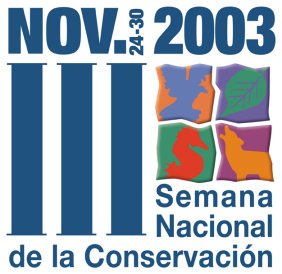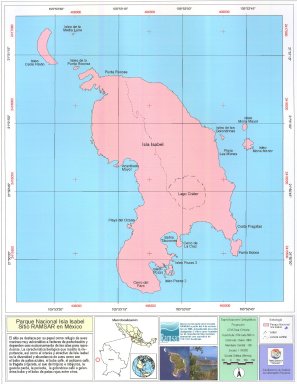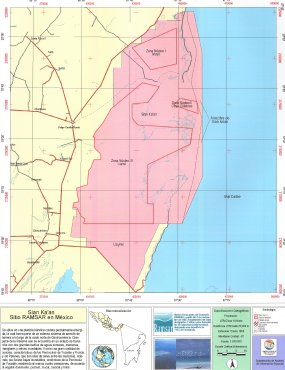Mexico designates ten new Wetlands of International Importance
In the third edition of the National Conservation Week, focusing on the International Year of Freshwater, Mexico is today announcing the designation of 10 new Ramsar sites with a total area of 777,814 hectares. This is a very important development of the implementation of the Ramsar Convention in Mexico, boosting its Ramsar sites number to 17, and reaching 1,881,790 ha of Ramsar sites in the country.
 The National Commission of Protected Areas (CONANP) promotes this week, celebrated every year in late November to commemorate the creation of the first protected area in the country more than 70 years ago. The National Conservation Week has been very successful in promoting conservation achievements in Mexico and involving municipal and state governments, NGOs, communities and the private sector in different conservation activities and events, while raising awareness about the importance of protected areas in the country. More information can be found in CONANP's press release (Spanish).
The National Commission of Protected Areas (CONANP) promotes this week, celebrated every year in late November to commemorate the creation of the first protected area in the country more than 70 years ago. The National Conservation Week has been very successful in promoting conservation achievements in Mexico and involving municipal and state governments, NGOs, communities and the private sector in different conservation activities and events, while raising awareness about the importance of protected areas in the country. More information can be found in CONANP's press release (Spanish).
The new Ramsar sites include several National Parks and a Biosphere Reserve, but also areas not otherwise protected. Worth highlighting are the efforts to designate sites with coral reefs, karstic systems, seagrass beds, mangroves, as well as two wildlife sanctuaries for the protection of nesting marine turtles.
Brief descriptions of the ten new sites have been prepared by Iván Darío Valencia based on the Ramsar Information Sheets submitted to the Secretariat, and further information about them in Spanish is available on the Web site of CONANP.
Cuencas y corales de la zona costera de Huatulco.27/11/03; Oaxaca; 44,400 ha; 15º47'N 096º12'W. National Park, Community Reserves. The site features coral reefs, uncommon in the Pacific littoral of Mexico, associated with shallow inlets in a coast dominated by cliffs. Mangrove forests are found at the outlet of some rivers and associated with several coastal lagoons. Inland, dry forests of priority importance for conservation are crossed by several freshwater currents. A wealth of fauna and flora inhabits the site, including several endangered and endemic species, including the amphibians Bufo marmoreus and Hyla sartori, the Sinaloa Wren Thryothorus sinaloa, the Golden-cheeked Woodpecker Melanerpes chrysogenys and the West Mexican Chacalaca Ortalis poliocephala, as well as numerous marine mammals that transit the coastline, such as the Pygmy and False Killer Whales (Feresa attenuata and Pseudorca crassidens) and the Long-finned Pilot Whale Globicephala macrorhynchus. Shellfishing, agriculture and tourism are the main activities in the area. Tourism development is considered to be the main threat due to large concentrations of people seasonally and the effect of new infrastructures. Forest clearing, hurricanes and hunting are also of concern. A management plan is in place for the Huatulco National Park and research activities are coordinated with several universities. Ramsar site no. 1321.
Laguna de Tecocomulco.27/11/03; Hidalgo; 1,769 ha; 19º52'N 098º23'W. Lying at 2514 m in the endorrheic basin of Tecocomulco, considered to be the last remnant of the ancient freshwater wetland system that dominated the Mexico Valley Basin in the centre of the country. Underlying aquifers are recharged through the lake, whose water level fluctuations are high. The site is noteworthy for 15 duck species, with congregations of Ruddy Ducks Oxyura jamaicensis of up to 5000 individuals, and of Moorhens Gallinula chloropus of up to 3000. The endangered Axolotl salamander Ambystoma mexicanum also inhabits the site. The Asian Carp (Cyprinus carpo) is commercially exploited by local fishermen. There are quotas for waterfowl hunting, which takes place especially during the winter. Erosion in the basin caused by agricultural activities and overgrazing provokes a high rate of sedimentation and turbidity in the lake. To address this problem, erosion control and forestation projects have been undertaken for basin management. Different universities are engaged in research and training. Ramsar site no. 1322.
Parque Nacional Arrecifes de Xcalak. 27/11/03; Quintana Roo; 17,949 ha; 18º20'N 087º48'W. National Park. A well preserved area on the Caribbean coast bordering Belize, comprising coral reefs, coastal lagoons, beaches, mangrove swamps and karstic aquifers. An atypical submarine relief of massifs and channels, known as "La Poza", is one of the main highlights of the site. Endangered and near-threatened animals such as Baird's Tapir Tapirus bairdii, the Jaguar Panthera Onca, the American Manatee Trichechus manatus, the Central American Cacomistle Bassariscus sumichrasti, and the Black Catbird Melanoptila glabrirostris inhabit the park. A number of waterbirds are common nesters in the site, while the mangrove swamps and lagoons are important for spawning Rock-cod Ephinephelus striatus. Coral reefs are dominated by Elkhorn Coral Acropora palmata and fish species such as Noronha wrasse Thalassoma bifasciatum and Blue Tang Acanthurus coeruleus. Commercial fishing is regulated, though closed seasons are not fully enforced. Scuba diving and sport fishing are the main tourist activities, but large-scale hotel developments are expected in the near future, with possible threats to the ecosystem. A management plan will soon be published addressing these issues. Ramsar site no. 1320.
Parque Nacional Isla Contoy. 27/11/03; Quintana Roo; 5,126 ha; 21º29'N 086º47'W. National Park. One of the northernmost islands in the Mesoamerican Barrier Reef, 50km north of Cancún and 13km off the mainland Yucatán peninsula, the principal nesting site for seabirds in the Mexican Caribbean. Coastal dunes, mangroves, lagoons, low forest and coconut palm trees dominate the terrestrial landscape of the island, while marine environments include sea-grass beds and coral reefs. Marine fish stocks are significant due to the abundance of plankton provided by the upwelling of cold submarine currents. Mammals are notably absent from the island. The endangered Green, Loggerhead, Hawksbill and Leatherback turtles nest on Isla Contoy, as well as the Horseshoe Crab Limulus polyphemus and large colonies of Magnificent Frigatebird Fregata magnificens, Double-crested Cormorant Phalacrocorax auritus and Brown Pelican Pelecanus occidentalis. A management plan regulates lobster fishing, sports fishing and tourist activities, and there is a fully equipped visitor and information centre. Rapid tourist development on the mainland coast poses threats to the island, as well as hurricanes such as Isidore in 2002. Ramsar site no. 1323.
 Parque Nacional Isla Isabel.27/11/03; Nayarit; 94 ha; 21º 51'N 105º 53'W. National Park. Volcanic island in the Pacific Ocean 70km off the port of San Blas. Deciduous tropical forest over lava soils, grasses, bare rock, islets, cliffs, sand beaches, surrounding coral reefs and a crater lake with hypersaline water compose a stunning landscape. Isla Isabel is one of the main nesting islands for seabirds in the Pacific, including large colonies of Magnificent Frigate birds Fregata magnificens (11,800 individuals), Blue-footed Boobies Sula nebouxii, Brown Boobies Sula leucogaster and Sooty Terns Sterna fuscata. Marine life is rich, with over 24 shark and ray species, three species of sea turtles, the California Sea Lion Zalophus californianus, Humpback Whale Megaptera novaeangliae and Killer Whale Orcinus orca. The island is uninhabited, though there is a seabird reproductive research program run by UNAM and tourists visit to camp, fish and bird watch. After having depleted a huge colony of Sooty Terns, which in 1978 had over 150,000 pairs, cats were finally eradicated from the island in 1995 and the Terns are slowly recovering. The impact of hurricanes, fishing activities and tourism has been of concern. A management plan is in a final stage of approval. Ramsar site no. 1324.
Parque Nacional Isla Isabel.27/11/03; Nayarit; 94 ha; 21º 51'N 105º 53'W. National Park. Volcanic island in the Pacific Ocean 70km off the port of San Blas. Deciduous tropical forest over lava soils, grasses, bare rock, islets, cliffs, sand beaches, surrounding coral reefs and a crater lake with hypersaline water compose a stunning landscape. Isla Isabel is one of the main nesting islands for seabirds in the Pacific, including large colonies of Magnificent Frigate birds Fregata magnificens (11,800 individuals), Blue-footed Boobies Sula nebouxii, Brown Boobies Sula leucogaster and Sooty Terns Sterna fuscata. Marine life is rich, with over 24 shark and ray species, three species of sea turtles, the California Sea Lion Zalophus californianus, Humpback Whale Megaptera novaeangliae and Killer Whale Orcinus orca. The island is uninhabited, though there is a seabird reproductive research program run by UNAM and tourists visit to camp, fish and bird watch. After having depleted a huge colony of Sooty Terns, which in 1978 had over 150,000 pairs, cats were finally eradicated from the island in 1995 and the Terns are slowly recovering. The impact of hurricanes, fishing activities and tourism has been of concern. A management plan is in a final stage of approval. Ramsar site no. 1324.
Parque Nacional Lagunas de Montebello. 27/11/03; Chiapas; 6,022 ha; 16º06'N 091º43'W. National Park. A complex of permanent and seasonal freshwater karstic wetlands and caves on the border with Guatemala, average altitude 1500m, amidst forests that share traits of tropical and temperate vegetation. Mixed communities of pine, oak and sweetgum Liquidambar styraciflua are dominant within the park. The site is noteworthy for its diversity of orchids, butterflies, and birds, the latter including the endangered Golden-cheeked Warbler Dendroica chrysoparia. Many of the caves are considered holy by indigenous communities, who visit them on pilgrimage. Locals live mainly off agriculture and tourism. Forest fires are increasingly common: in 1998, 50% of the park was burnt. Water pollution and unregulated tourism are also of concern, but a management mlan was recently finished to address these and other issues. Awareness campaigns are constantly carried out with locals and there are ongoing research activities. The site has been classified as an Important Bird Area. Ramsar site no. 1325.
Playa Tortuguera Rancho Nuevo. 27/11/03; Tamaulipas; 30 ha; 23º14'N 097º46'W. Wildlife Reserve. A stretch of sandy and gently sloping beach of over 30km on Gulf of Mexico, the only reproductive area in the world for the Atlantic Ridley Sea Turtle Lepidochelys kempi, which is endemic and critically endangered. The also endangered Green Turtle Chelonia mydas nest on the beach, and sporadically the Loggerhead and Hawksbill Turtle. Since 1964, study and monitoring of the turtle nesting seasons have taken place jointly between Mexican and U.S. institutions. Areas of intertidal marshes, mangroves, lagoons and low deciduous forests are other features of the site. There is an important level of diversity of mollusks, crustaceans, fish, birds and marine mammals. The area is off limits to outside visitors, but local people harvest oyster and crab. Ramsar site no. 1326.
Playa Tortuguera Tierra Colorada. 27/11/03; Guerrero; 54 ha; 16º25'N 098º38'W. Wildlife Reserve. An ocean-battered beach on the south central Pacific Coast, one of the most important nesting areas for the critically endangered Leatherback Turtle Dermochelys coriacea, and relevant also for the endangered Olive Ridley Turtle Lepidochelys olivacea and Green Turtle Chelonia mydas. American Crocodiles Crocodilus acutus have also been reported. Coastal dune vegetation, mangrove forests and desert scrub are found in the area, which although modified by anthropic uses sustain important biodiversity. Fishing is an important economic activity, and there is considerable exploitation of turtles and other reptiles for selling and eating. Cattle and dogs on the beaches are a problem, as well as coconut and mango plantations and potential threats from plans for new tourism development and the dredging of the beach for a wharf. Since 1995, UNAM and SEMARNAT have carried out research on marine turtles and seasonal beach cleaning campaigns. Ramsar site no. 1327.
Reserva Estatal El Palmar. 27/11/03; Yucatán; 50,177 ha; 21º03'N 090º12'W. State Reserve. The site lies on the northwestern coast of the Yucatán peninsula and features mangroves, seagrass beds and tidal flats, as well as coastal dune vegetation, petenes (emerging islands of forests protected from saline intrusions), sinkholes or cenotes, swamp forests and low deciduous forest. El Palmar harbours a significant population of Greater Flamingos Phoenicopterus ruber, and 15 duck species have been recorded. The site also provides nesting ground for the endangered Hawksbill turtle Eretmochelys imbricata, for which a nest survey and liberation programme is underway. Fishing, agriculture, hunting and palm leaf collection are the main economic activities, which also represent the main potential threats to the site. Federal, state and municipal authorities as well as NGOs, communities  and academic institutions participate in a board that manages the reserve. Training, restoration and awareness activities have been carried out successfully. Ramsar site no. 1328.
and academic institutions participate in a board that manages the reserve. Training, restoration and awareness activities have been carried out successfully. Ramsar site no. 1328.
Sian Ka'an.27/11/03; Quintana Roo; 652,193 ha; 19º30'N 087º37'W. World Heritage Site, Biosphere Reserve, Wildlife Protection Area. The site lies on a large karstic plain along a 120km-long barrier reef. Two large, shallow bays surrounded by mangroves, as well as numerous sinkholes or cenotes, are main landmarks in a landscape of tropical deciduous forests. Endemic communities of swamp forests and of petenes, emerging islands of forests protected from saline intrusions, are mostly pristine and of global significance. There is a wealth of flora and fauna, including 320 bird species and 5 Neotropical felines. Endangered species include Green, Loggerhead, Hawksbill and Leatherback turtles, American and Belize Crocodiles Crocodylus acutus and C. moreletii, Baird's Tapir Tapirus bairdii, Jaguar Panthera Onca, Puma Puma concolor, American Manatee Trichechus manatus and Sperm Whales Physeter catodon. Mayan archeological sites have been found in the Reserve. Several tree species are used for wood, and forest products such as thatch palm leaves and resin for chewing gum are extracted. The main problems are due to overfishing, increasing tourism, forest fires and invasive species. There is a management plan in place and several research activities have been undertaken. A community program training locals as tourist guides has started in order to manage tourism beneficially. Ramsar site no. 1329.